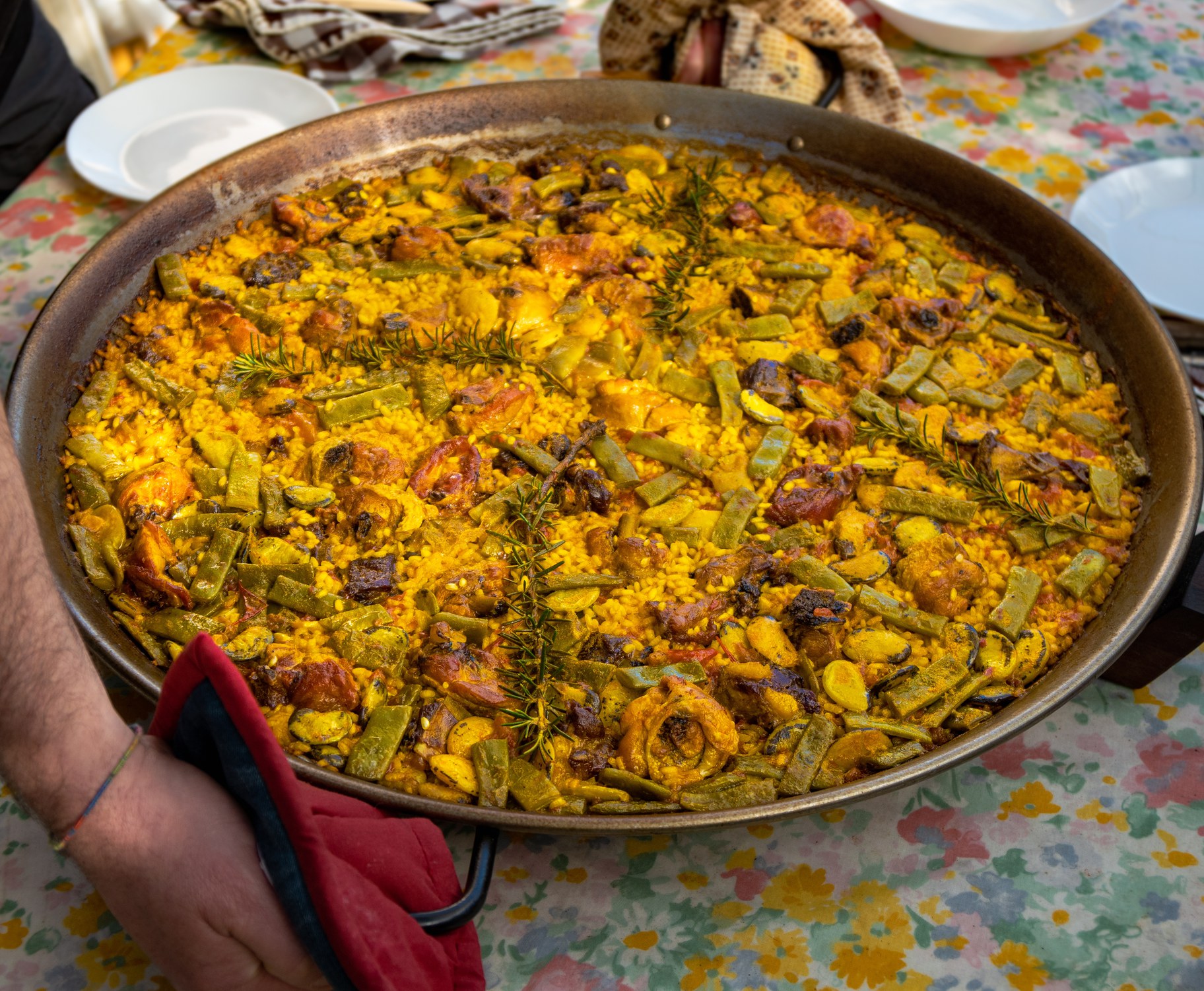It stopped raining, let’s make paella! Sure you can make it in the kitchen, but if you have a burner you can use outside, paella is the perfect dish for entertaining. And when I say dish, I really mean pan because the way you create the perfect paella is to have the right size pan for the number of people you’re hosting. I have two, a 13” for four to five people and a 20” for five to eight guests. I know that people are passionate about the dish and care greatly about the nomenclature, so I am going to call this Arroz con cosas or rice with things.
During the lockdown portion of the pandemic I taught several classes on Zoom. My favorite was bi-continental with Matt Goulding of Roads and Kingdoms. I was in my garden in the light of day. He was in his kitchen in Barcelona in the evening. Here is his recipe that we made together.
The most important thing to know about making paella or arroz con cosas is that the size of pan dictates the amount of ingredients because the level of rice remains constant. Because paella cooks without a lid to steam the rice, the amount of rice needs to be enough to be a thin layer in the pan before the liquid is added, so that it can cook just by simmering. Also the crunchy semi-burnt bottom or socorrat is all important when making this dish, which is why you’re not piling on the rice. The layer of cooked rice should be about the width of a fat finger.

A pan of paella is served. Photo courtesy of Shutterstock.
Matt Goulding’s Arroz con cosas (serves four to six people) and uses a 13” or 15” paella pan.
This is from Matt Goulding, with whom I co-taught a bi-continental cooking class during the pandemic.
A classic Valencian paella is made with chicken, rabbit, snails, plus a handful of local legumes, but I rarely make a true paella. Instead, I make arroz con cosas — a catch-all term for something inspired by paella, but not strictly adherent to its ingredient list. (Here is Matt’s essay on Paella from his book, “Grape, Olive, Pig.”) Instead, I use some piece of the basic Valencian formula but adapt it throughout the year to whatever looks best in the market. Could be Brussels and sweet potatoes in the winter, or eggplant and zucchini in the summer, or, as I'm using here: artichokes, asparagus, and peas in the early spring (that is, if you're lucky enough to live in California or Catalunya). If you don't get these exact ingredients, no worries — you can make almost any vegetable work with a Spanish rice variety as long as the ingredients are cut into bite-size pieces. Adaptations are welcome.
- Extra virgin olive oil
- 1 lb. chicken boneless, skinless chicken thighs, cut into 2” pieces or 8 chicken wings, (optional)
- 2 large artichokes, peeled of all tough exterior leave, choke removed, and cut into quarters or eighths and left in acidulated water or 8 large baby artichokes, trimmed and cut in half
- 1 lb sugar snap peas (or regular green beans)
- 2 cloves garlic, minced (or 4 Tbsp minced green garlic)
- 1.5 lb fresh tomatoes (Roma or other decent, juicy tomatoes...even offseason), peeled and finely chopped (the Spanish way is to cut the tomatoes in half and grate with a box grater, discarding the skin after you've grated all the flesh)
- 8-10 medium asparagus, woody ends removed, cut into 1-inch pieces
- A few shakes of smoked paprika
- A couple generous pinches of saffron
- 400g or 14 oz. Bomba rice
- 6-7 cups water vegetable or chicken stock (I make a quick chicken stock with browned chicken wings and veg scraps an hour before I cook the rice...)
- Sprig of rosemary
It's important to have a good heat source if using a larger paella pan — either a grill that gives off good heat, or even better, a Spanish-style rice burner. Failing that, you may need to straddle the pan over multiple burners to get an even cook, or just be prepared to finesse the pan over a single burner throughout the cooking process.
Heat a generous film of olive oil over medium heat. Cook the chicken until lightly browned and the fat begins to render if skin on. Season with a bit of salt as it cooks.
Add the artichokes and sugar snaps, saute briefly, using tongs to distribute throughout the pan. Add the tomato and garlic and continue to cook until the water cooks out of the tomatoes and they begin to thicken and cling to the protein and veg. Add the asparagus, then season with a good amount of salt, a few shakes of smoked paprika, and a good pinch of saffron. Add the rice, stir briefly to distribute across the pan, then add liquid. Set a sprig of rosemary afloat in the rice sea. If the liquid evaporates too quickly add a bit more as needed.
Cook for 20 minutes, over low heat without stirring, until the water has evaporated and the rice has begun to brown and stick gently to the bottom of the pan (an alchemic transformation known as socarrat). Eat, drink, be merry.
If you’re hungry for paella now after all of this and just want to eat it, here are some suggestions where to dine.
A.O.C.
West Hollywood/Brentwood
El Coraloense
Bell Gardens
-Paella on Thursdays only
Gabi James
Redondo Beach
Gasolina Cafe
Woodland Hills
La Española
Harbor City
-They are a fantastic resource for the pans and all Spanish ingredients. They also serve paella on Saturdays.
La Paella
Beverly Grove
Otoño
Highland Park

